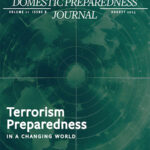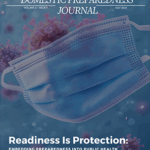“Hello, this is Kristina with Harris County. You’re receiving this call because you are registered with the State of Texas Emergency Assistance Registry (STEAR). Due to the extended power outages from Hurricane Beryl, we are reaching out to see if you have any medical needs or need other assistance.”
Hundreds, if not thousands, of calls like that took place in the Harris County Emergency Operations Center in the two weeks following Hurricane Beryl on July 9, 2024, and after other recent incidents that impacted the county. Each call is unique and, although most end with the recipient confirming they are okay, a wide range of needs and challenges have been discovered.
During one call, for example, a daughter expressed concern about her mother’s back wound requiring daily care, but they lacked essential supplies like gauze and tape. In response, Harris County Office of Homeland Security & Emergency Management (HCOHSEM) coordinated with the Harris County Fire Marshal’s Office, which promptly dispatched Little York Fire Department. They provided immediate assistance by tending to the wound and supplying several days’ worth of bandages and medical supplies to the woman in need.
What Is STEAR?
Following hurricanes Katrina and Rita in 2005, the State of Texas created the Transportation Assistance Registry to assist emergency managers and other officials in determining the types of transportation individuals in their jurisdictions may require in case of evacuation. That tool evolved over time as entities began realizing they would need a tool to capture needs beyond transportation during an emergency.
The Texas Division of Emergency Management created the State of Texas Assistance Registry (STEAR) in March 2013 as a tool for emergency responders and planners to assist residents with varying needs during an evacuation. Since then, HCOHSEM has promoted it publicly and included STEAR in evacuation planning. HCOHSEM reminds residents about STEAR as part of hurricane preparedness information throughout the year.
Generally, those encouraged to register with STEAR are residents with disabilities or functional and access needs. Nursing homes, home health organizations, and similar facilities licensed by the State of Texas must register the facility with the system so that planners can make adequate arrangements in an emergency.
After the and the associated extended power outages, the Texas legislature passed Senate Bill 968 (SB968), which included completing wellness checks on medically fragile individuals who have registered in the STEAR database in the event of:
- Extended power, water, or gas outages lasting more than 24 consecutive hours;
- Declared state of disaster by the governor; or
- Any other event considered necessary by the Texas Division of Emergency Management, Texas Department of State Health Services, or Texas Department of Health and Human Services.
This law also outlined what these residential checks would look like and how to implement them.
Not long after this bill became law, HCOHSEM’s Planning Section and other Harris County departments—notably the Harris County Fire Marshal’s Office—began working on how to comply with these rules and ensure wellness checks on some of Harris County’s most vulnerable residents during events like the historic winter storm of 2021.
HCOHSEM decided to add their STEAR registrants to the mass notification system database to simplify the communication process. This step provides the opportunity for proactive communication, ensuring STEAR registrants are aware of significant milestones, such as the start of hurricane season and impending local weather events. The preemptive calls and messages are reminders that registrants have a role in planning for their own safety and that Harris County support is available if necessary.
Derecho and Hurricane Beryl in 2024
On May 16, 2024, following a flooding event, a derecho swept through Harris County and caused immense damage. The winds, which equaled a Category 1 hurricane, and some tornadoes caused a path of destruction that began in the northwest corner of Harris County, traveled through the heart of downtown Houston, and exited the county’s southeast corner.
Initial estimates for power outages were measured in weeks after damage to at least ten power transmission lines in the region. The towers holding the lines were twisted and knocked down due to the force of the winds that swept across the region. Other parts of the electric infrastructure suffered damage from fallen trees, debris, and other high winds, which made it difficult to know how long the outages would last.
Almost two months later, on July 8, Category 1 Hurricane Beryl made landfall in Southeast Texas, leaving over 2 million residents without power. On July 11, over 1 million people were still without power due to Beryl’s winds across a large swath of the area.

Figure 1. Derecho damage corridor (Source: HCOHSEM Tech Unit, May 2024).
Wellness Check Mobilization – Derecho
The anticipated extended power outage led to HCOHSEM proactively initiating plans to contact STEAR registrants in unincorporated Harris County. On May 17, 2024, HCOSHEM utilized its mass notification system to contact STEAR registrants with a message encouraging them to enact their personal preparedness plans due to a potential extended power outage.
At the same time, HCOHSEM shared data with the Harris County Fire Marshal’s Office, delineating which fire department or emergency service district served each resident on the list. Fire departments and emergency service districts could use this information to conduct wellness checks and report to the Harris County Emergency Operations Center. Of the 1,030 registrants on the list, local departments successfully contacted 605.
 Figure 2. Representatives from the Southeast Texas Regional Advisory Council’s Catastrophic Medical Operations Center, Harris County Public Health, and HCOHSEM calling STEAR registrants after Hurricane Beryl (Source: HCOHSEM, 2024).
Figure 2. Representatives from the Southeast Texas Regional Advisory Council’s Catastrophic Medical Operations Center, Harris County Public Health, and HCOHSEM calling STEAR registrants after Hurricane Beryl (Source: HCOHSEM, 2024).
For the 425 not reached, HCOHSEM sent a follow-up message on May 18 containing a poll asking whether they required assistance. The poll reduced the number of non-respondents to 360 and refocused efforts on that group of individuals.
To address these remaining cases, HCOHSEM collaborated with the following agencies:
- Catastrophic Medical Operations Center,
- Harris County Housing & Community Development Office of Transit Services, and
- Harris County Public Health.
HCOHSEM and Harris County Public Health collaborated to establish a call center whose goal was to determine the following:
- Urgent medical needs such as oxygen, reliance on power-dependent medical equipment, or medication;
- Requirements for wellness checks;
- Need for shelter (cooling centers due to unseasonably warm weather or for device charging); and
- Other unmet needs.
Responses were tracked in real-time through a shared spreadsheet where select partners in the Harris County Emergency Operations Center could see needs and manage them under the following categories:
- Urgent medical need or wellness: Routed to the Catastrophic Medical Operations Center;
- Shelter requirement: Routed to the Harris County Housing & Community Development Office of Transit Services for transportation coordination; and
- Other needs: Advised to call 211.
In most cases, those who answered indicated they were okay but shared appreciation that someone contacted them.
In other cases, there was a notable interaction from these calls, with registrants reporting concerns for others. For example, one registrant reported being okay but shared concern about the registrant’s daughter, who was experiencing homelessness. Utilizing a description of the daughter and her last known location, the Harris County Emergency Operations Center coordinated with the City of Houston’s Emergency Operations Center and Houston Police Department to complete a welfare check. The person’s daughter was located, and the operators called that person back with an update, which they greatly appreciated.
Checks continued into May 19, and the Harris County Emergency Operations Center re-attempted to contact registrants flagged as having non-working numbers, full voicemails, or busy signals. They connected with some registrants they could not reach the day before, confirming many were safe and routing the others to the Catastrophic Medical Operations Center or Harris County Housing & Community Development Office of Transit Services for follow-up action.
In one instance, an elderly resident indicated she had no needs as a result of the storm but had other unmet needs due to being on a fixed income. The Harris County Emergency Operations Center coordinated with the Harris County Housing & Community Development Office of Transit Services to bring her Meals Ready to Eat (MREs), water, a solar charger, and resource flyers. Additionally, they shared her information with the American Red Cross to follow up and connect her with services.
After these completed checks, only 63 of the initial 1,030 registrants remained uncontacted. At that point, the geographic information system (GIS) team was brought in to utilize STEAR data and power outage information to determine which registrants were in areas with prolonged power outages. The team was able to distinguish residents-based responses in their registration information, providing a greater understanding of individuals’ needs. That response data reduced the list of 63 to 17, of whom 13 were in the medically fragile category. Fire department wellness checks, home health care, emergency contacts, and one of the county commissioners’ offices addressed these 13 cases.
On May 21, a recovery message was sent to all STEAR registrants in English and Spanish, providing them with information on available resources to aid in recovery and an update on power restoration efforts. The message included information about local resources such as cooling centers, 211, and HCOHSEM’s ReadyHarris social media channels and website (ReadyHarris.org). It also included information regarding applying for federal assistance since this was a federally declared disaster.
Lessons Learned – Derecho
Having the most up-to-date data was crucial in ensuring outreach efforts were made using current registration information instead of relying on previous years’ data. Another important aspect was having data custodians familiar with the STEAR database. Current data and trained staff help ensure that the appropriate authorities and agencies can access regularly updated information and reach residents as needed. While not all cities and counties in Texas participate in STEAR, it may be worth joining or developing a resource to provide awareness of residents needing assistance and ensure compliance with SB968 or similar legislation in other states.
The ability to map locations of STEAR registrants in the impacted areas is a best practice that HCOHSEM will utilize moving forward as the maps indicate the registrants who were on the derecho’s path. While having GIS professionals on staff may not be possible for all jurisdictions, partnerships enabling access to these tools and skills may be a worthwhile endeavor for situational awareness and speedier response times.
Wellness Check Mobilization – Beryl
Utilizing the lessons learned after the derecho, HCOHSEM and partners geared up to reach almost 1,300 registrants as Beryl started heading toward Harris County. This was a larger number than the derecho due to the broader impact area and increase in sign-ups following the derecho.
On July 6, 2024, two days before Beryl made landfall, an initial preparedness message was sent to registrants through the mass notification system, encouraging them to enact their personal preparedness plans. On July 8, polling messages like the ones after the derecho were sent to registrants asking if they needed assistance. Based on the number of responses to the polls, the number of registrants still requiring checks was reduced to 882.
With that list in hand, HCOHSEM stood up a call center in the emergency operations center along with a remote one staffed by Harris County Public Health. Those efforts reduced the list to only a few hundred. However, due to cellular coverage outages and other communications issues caused by power outages, the team completed another round of calls and messages to reach registrants.
If a registrant indicated that they needed assistance, they were routed to either:
- Catastrophic Medical Operations Center (for medical),
- Harris County Fire Marshal’s Office (for wellness checks that had an EMS component),
- Harris County Sherriff’s Office (for general wellness checks), or
- Harris County Housing & Community Development Office of Transit Services (for transportation).
As extended power outages continued, the HCOHSEM team worked with first responders and county commissioner precincts to provide wellness checks to residents who were not reached by phone or message. To assist with this mission, a STEAR Concept of Operations was developed to give responders a playbook for addressing various needs that may arise, including, but not limited to, shelter, food or water, or a medical need.
Additionally, HCOSHEM and partners developed a tracking system to allow for real-time coordination from the emergency operations center for any needs that may arise from the field. As a follow-up, a message sharing information about recovery resources to help residents in the aftermath of Hurricane Beryl was sent to STEAR registrants on July 22 to ensure they were aware of resources.
Lessons Learned – Beryl
The methodology developed during the derecho response worked well across this event as well. The main change needed was to send multiple polling messages due to communications interruptions from infrastructure damage and power outages.
Developing a concept of operations for those participating in this STEAR mission was critical for ensuring all responders had the support necessary for them to be successful in addressing the various situations they might encounter. This support included important phone numbers to share, locations of shelters, and where to obtain water, food, and other items for those in need.
Lessons Learned – STEAR
The key to reaching over 2,000 registrants two times in less than three months was having deep relationships with a robust network of partners. HCOHSEM can tap into that network during grey skies by cementing relationships during blue skies. Each partner was familiar with each other’s capacities and capabilities, which allowed for problem-solving and action to serve the residents of Harris County. Close relationships with Harris County Public Health, Harris County Housing & Community Development Office of Transit Services, and Catastrophic Medical Operations Center allowed for quick response to meet needs like setting up a phone bank, providing transportation, and getting oxygen to those in need.
The most important aspect of the STEAR plan is that it is scalable. While not all jurisdictions may have a robust network of first responders and supporting agencies who can mobilize for calls and wellness checks, many might consider utilizing nontraditional agencies. Parks and recreation team members, community center staff, or others who have customer-service-centric roles could reach out to those on their STEAR lists. Additionally, other jurisdictions may consider combining efforts to support others in times of need.

Jamie Hannan
Jamie Hannan, MAT, MPP, is the innovation research analyst for the Harris County Office of Homeland Security & Emergency Management (HCOHSEM) in Harris County, Texas. He joined the team in 2021 after working in the nonprofit and education sectors for a decade. In his role at HCOHSEM, he works across sections to highlight best practices and innovative processes, researches trends in emergency management, serves as a policy analyst, supports disaster recovery operations, and acts as a liaison to the commissioners court, the local governing body for Harris County. Most recently, Jamie served as deputy incident commander for the Texas Severe Storms, Straight-line Winds, Tornadoes, and Flooding disaster recovery operations and served in a recovery leadership role for Hurricane Beryl. He holds a B.A. in history and an M.A. in teaching from Austin College in Sherman, Texas, and a master of public policy from the Hobby School of Public Affairs at the University of Houston.
- Jamie Hannanhttps://domesticpreparedness.com/author/jamie-hannan
- Jamie Hannanhttps://domesticpreparedness.com/author/jamie-hannan
- Jamie Hannanhttps://domesticpreparedness.com/author/jamie-hannan
- Jamie Hannanhttps://domesticpreparedness.com/author/jamie-hannan

Kristina Clark
Kristina Clark is the access and functional needs planning manager for the Harris County Office of Homeland Security & Emergency Management (HCOHSEM). HCOHSEM is responsible for disaster planning, preparedness, response, and recovery in the nation’s third most populous county. Clark joined HCOHSEM in 2009 and has worked to integrate equity, accessibility, and a whole community approach into all-hazards emergency management planning. She manages the State of Texas Emergency Assistance Registry (STEAR) for Harris County. She serves as a liaison to the Catastrophic Medical Operations Center, the Coalition for the Homeless, independent school districts, and Voluntary Organizations Active in Disasters (VOAD). In addition, she co-chairs the region’s Disability Access & Functional Needs (DAFN) Workgroup. As part of HCOHSEM’s Planning Section, Clark supports and maintains the Harris County Basic Plan, Shelter and Mass Care Plan, Volunteer Reception Center Plan, and the Pandemic Plan, to name a few. During emergency operation center activations, Clark has served as the planning section chief, deputy planning section chief, and situation unit leader for many activations, including Hurricane Harvey, Tropical Storm Imelda, Winter Storm Uri, COVID-19, Super Bowl LI, 2018 NCAA Final Four, the World Series, and weather-related events.
- Kristina Clarkhttps://domesticpreparedness.com/author/kristina-clark





